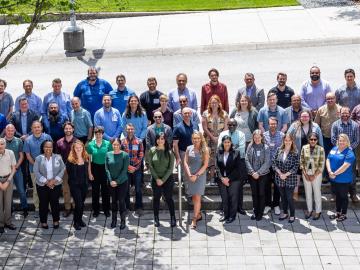
Filter News
Area of Research
News Topics
- (-) Advanced Reactors (3)
- (-) Clean Water (2)
- (-) Composites (5)
- (-) Cybersecurity (2)
- (-) Isotopes (10)
- (-) National Security (13)
- (-) Nuclear Energy (14)
- (-) Quantum Science (14)
- (-) Space Exploration (5)
- (-) Summit (8)
- 3-D Printing/Advanced Manufacturing (17)
- Artificial Intelligence (21)
- Big Data (7)
- Bioenergy (11)
- Biology (11)
- Biomedical (7)
- Biotechnology (4)
- Buildings (7)
- Chemical Sciences (7)
- Climate Change (9)
- Computer Science (28)
- Critical Materials (2)
- Decarbonization (12)
- Education (1)
- Emergency (1)
- Energy Storage (7)
- Environment (19)
- Exascale Computing (7)
- Fossil Energy (2)
- Frontier (6)
- Fusion (7)
- Grid (9)
- High-Performance Computing (9)
- Machine Learning (6)
- Materials (10)
- Materials Science (14)
- Mathematics (3)
- Mercury (1)
- Microscopy (3)
- Molten Salt (1)
- Nanotechnology (3)
- Net Zero (3)
- Neutron Science (10)
- Partnerships (11)
- Physics (6)
- Polymers (3)
- Quantum Computing (9)
- Security (4)
- Simulation (10)
- Statistics (1)
- Sustainable Energy (14)
- Transportation (9)
Media Contacts
Joe Tuccillo, a human geography research scientist, leads the UrbanPop project that uses census data to create synthetic populations. Using a Python software suite called Likeness on ORNL’s high-performance computers, Tuccillo’s team generates a population with individual ‘agents’ designed to represent people that interact with other agents, facilities and services in a simulated neighborhood.

Two ORNL teams recently completed Cohort 18 of Energy I-Corps, an immersive two-month training program where the scientists define their technology’s value propositions, conduct stakeholder discovery interviews and develop viable market pathways.

Brittany Rodriguez never imagined she would pursue a science career at a Department of Energy national laboratory. However, after some encouraging words from her mother, input from key mentors at the University of Texas Rio Grande Valley, or UTRGV, and a lot of hard work, Rodriguez landed at DOE’s Manufacturing Demonstration Facility, or MDF, at Oak Ridge National Laboratory.

ORNL hosted the Mid-South Regional Chapter of the American Society for Photogrammetry and Remote Sensing, or ASPRS. Participants spanning government, academia and industry engaged in talks, poster sessions, events and workshops to further scientific discovery in a field devoted to using pictures to understand changes to the earth’s inhabitants and landscape.

A newly established internship between ORNL and Maryville College is bringing cybersecurity careers to a local liberal arts college. The internship was established by a Maryville College alumni who recently joined ORNL.

As a data scientist, Daniel Adams uses storytelling to parse through a large amount of information to determine which elements are most important, paring down the data to result in the most efficient and accurate data set possible.

SCALE users from 85 organizations across 21 countries gathered online and in person at Oak Ridge National Laboratory from June 5 to June 7 for the Eighth Annual SCALE Users Group Workshop. The meeting included 32 presentations and 14 hands-on tutorials on impactful and innovative applications of SCALE.

Andrew Conant from ORNL's nuclear nonproliferation division is collaborating with national laboratories to analyze isotopes generated in nuclear reactors. This research aims to glean insights into the operations and objectives of these reactors. ORNL, renowned for its leadership in nuclear research, maintains its legacy by promoting the peaceful utilization of nuclear energy worldwide.

Despite strong regulations and robust international safeguards, authorities routinely interdict nuclear materials outside of regulatory control. Researchers at ORNL are exploring a new method that would give authorities the ability to analyze intercepted nuclear material and determine where it originated.

Researchers used quantum simulations to obtain new insights into the nature of neutrinos — the mysterious subatomic particles that abound throughout the universe — and their role in the deaths of massive stars.


